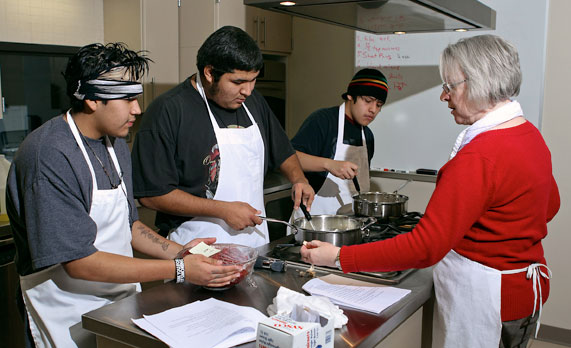SDSU, Flandreau tribe join to restore Bison as food source
Tatonka!

Students and cooks from the Flandreau Indian School learn the science as well as the creative aspects of bison meat preparation.
That’s what Native Americans used to refer to as their substance of life. Today, most Americans just call it a buffalo. But the true term for this 1,500- to 2,200-pound animal is the American Bison.
Standing seven feet at the shoulder, it once roamed the plains of America as numerous as the stars in the heavens. The giant herds once provided Native Americans with food, clothing, teepees, tools, weapons, and they were also important culturally, figuring prominently in religious traditions.
Presently, Native American communities are at the forefront of stewardship activities to maintain a healthy bison population in the United States. As part of this effort, Native American organizations are investing resources to manage bison herds and find innovative marketing alternatives for this traditional source of protein. One unique concept is the development of an organic bison production system that will provide local tribal communities with a low fat protein source to replace higher fat content food alternatives.
Thanks to a collaboration between the Flandreau Santee Sioux tribe and SDSU scientists, efforts are taking place to enhance the role of bison in local economic development and increase consumption of bison meat among tribal community members.
One aspect of the collaborative effort is the provision of cooking demonstration classes and educational outreach opportunities for students at the Flandreau Indian School. The program provides students with classes on preparing and consuming bison meat as a healthy and flavorful alternative to less healthy meal options.
Organic the way
Flandreau Santee Sioux tribal members maintain their own herd as a tie to their ancestors, used primarily as a ceremonial and cultural icon. However, as herd size increased so did the cost of maintaining it, and as a result, the herd placed an economic burden on tribal resources. Tribal officials then contacted SDSU researchers to develop a new production and marketing system that included a market option within the community.
“Even though the bison is culturally important to tribal members, Native Americans are used to eating traditional American foods,†says SDSU Economics Professor Scott Fausti. “We’re trying to lessen the financial burden by integrating the bison into the community and use the animal as a substitute protein source.â€
The tribe has culled the herd from 250 animals in 2009 to fewer than 50 as it works to regrow them organically without hormones or pesticides, which is more in line with traditional American Indian beliefs.
The herd will return to about 140 organically grown bison, supplying 25 to 30 animals each year for community consumption, says Fausti, who points to an agreement with the Elkton Meat Locker.
“The organic bison will be processed there for the community,†he says. “Before, they were selling them to a feedlot in Nebraska.â€
Fausti is one of 20 SDSU professors from seven campus departments involved in the project. Along with economics, the other departments are animal science, plant science, political science, veterinary and biomedical sciences, natural resource management, and health and nutritional sciences.
Not like roast beef
Processing bison is one thing, but cooking it is yet another item to master, and that’s where health and nutritional sciences comes into play with the department’s high-tech arena—the Faye Tyler Wade Food Laboratory.
“This is what we do here,†says Professor Padmanaban Krishnan, whose department welcomes students and cooks from the Flandreau Indian School to learn the science as well as the creative aspects of bison meat preparation.
“Flandreau Indian School students get out of school and spend time at our university,†he says. “In our lab they have a fun, food learning event—an encounter they otherwise would not have.â€
According to Professor Kendra Kattelmann, director of the SDSU dietetic program, bison is an excellent lean protein source. “When used as a replacement for a higher calorie food, bison reduces energy intake of the diet, lowers calorie intake, prevents against excessive weight gain, and thus diabetes.â€
Krishnan views the project as a golden opportunity to impact the health and nutrition of a Native American community right here in South Dakota.
“Bison, after all, is a symbolic animal. It’s more than just food, it’s also a part of spirituality. It’s a good feeling being involved in a project that helps a constituent group in so many important ways.â€
Kyle Johnson






